Chinese scallion pancake (Cong You Bing, 葱油饼) is not like any other pancake familiar to most of the people. It has a crusty and crispy surface, with scallions sandwiched between layers of pastry inside. It is a refreshing, delightful, and easy to make flatbread.
These pancakes are savory and are most suitable as snacks in between main meals or for breakfast.
The making of the Chinese scallion pancake is straightforward, albeit there are a few tricks to make it crusty, fluffy, and with distinct layers.
Let’s dive into the details right away.
Note: Scallion is also known as green onion and spring onions in some parts of the world.
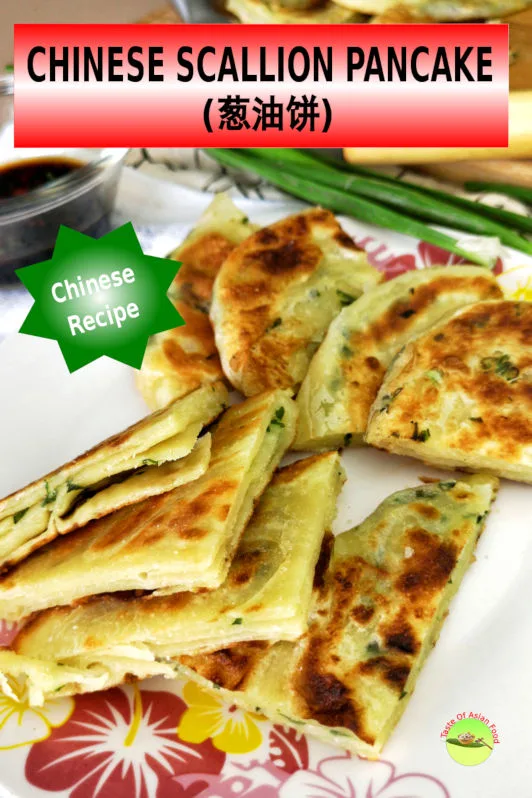
Note: This post may contain affiliate links. Please read my privacy policy for more info. I may receive commissions for purchases made through links in this post. As an Amazon Associate, I earn from qualifying purchases.
1. Prepare the pancake dough
Is it necessary to use warm water to make the dough?
I came across a Chinese scallion pancake recipe using warm water to prepare the dough.
After reading various resources and still failing to unveil the mystery, I decided to test the difference between using warm and cold water.
The result turns out to be identical. Therefore, I will use cold water for this recipe.
Add some salt to the dough
I prefer to add part of the salt while kneading the dough and sprinkle the other half onto it after rolling it out.
The salt that sprinkled and trapped in between the layers gives a more distinct flavor that tickles the taste buds. The effect is similar to sprinkle the salt on the steak instead of rub in thoroughly.
What type of flour is best for the scallion pancake?
I am using plain flour (all-purpose flour) in the recipe, which yields a stretchable dough. I also came across a recipe using bread flour.
So I try to make some with bread flour. The dough does not turn out as stretchy as using plain flour, and a bit difficult to roll it out thinly. I suspect it is due to the presence of gluten that makes it more elastic. For now, I will stick to all-purpose flour for making Chinese scallion pancakes.
Here are the steps to make the dough.
- Add water and salt to form a shaggy dough.
- Knead five to eight minutes by hand, or use an electric mixer until it forms a very sticky and relatively smooth and elastic ball.
- Continue kneading until it becomes shiny and stay clear from the mixing bowl.
Tip to keep the kneading process clean and tidy
The dough of the Chinese scallion pancake is very sticky due to the high water content. I am using 70ml of water for every 100g of flour. You will immediately reckon that it is a shaggy dough if you are making bread regularly.
My method is hands-free. Measure the flour, water, and salt required in a mixing bowl. Combine them with a sturdy silicone spatula for a few minutes until the dough becomes an elastic ball, and picks up all the flour and sticky pieces in the mixing bowl.
You can also use a handheld electric mixer with a dough hook when you make a large batch.
When the dough is ready, cover and let it relax before continuing with the next step. The whole process is tidy and clean since I do not knead it with my hand nor remove it to another container for resting. (I have recorded how I did it in the video in this article.)
After mixing, let it rest for thirty minutes before rolling it out.
2. How to shape ad create the layers of the scallion pancake
The layers of the Chinese scallion pancake are created by applying oil on the roll-out dough, and then roll and fold like making puff pastry.
- After resting the dough for thirty minutes or longer, place it on a floured surface.
- Divide the dough into four portions (for four pancakes).
- Push down a portion with your palm, then roll it thinly. You can either roll it into a circle or a long rectangle as thin as possible. Since the dough is quite wet, you need to lift the dough and transfer it to the floured surface next to it whenever you feel that it starts to stick to the surface. I prefer a rectangle because it is easier to shape it into a long strip.
Two ways to apply the oil that forms layers
There are two methods to apply the oil to create the layer:
- Brush the cooking oil liberally on the roll-out dough and leave about a centimeter clear from the edges.
- Combine the oil and some flour in a small pan over low heat. Keep stirring it quickly until it becomes a roux (called 油酥 in Chinese). Once the roux is cold, transfer it to the surface of the dough.
I have tried both methods, and they all work well. I prefer the roux method since a thick roux is easier to manage and less likely to leak out from the dough while shaping it.
- Next, sprinkle some salt evenly on the surface.
- Cut some scallions crosswise thinly, about 1 to 2 mm. The scallions will stick out from the layers if they are too large.
- Sprinkle the scallions evenly on the surface.
Creating the layers of the pancake
- Roll up the longer side of the pastry, like making Swiss roll to form a long strip. Squeeze to seal up both ends.
- Roll and stretch the dough with your palm to make it into a long rope.
- Coil up the rope and tuck the end of it underneath the dough.
- Let the dough relax before rolling it to a circle.
- Push down the dough with your palm. Roll out to form a circle, about half centimeter thick. The thinner you make, the crispier it will be, but you are risking to break the layers, and the oil will leak out, which will ruin the layers.
Tip: Do not break the air bubbles while rolling out the dough. The air trapped in between the layers will expand during frying and separate the layers.
3. Pan-fried the pancakes
Now it comes to the part. Here are the steps:
- Add some oil to a frying pan over medium heat. When the oil is hot, place the pancake on it and pan-fry for about three minutes or until it turns brown with some beautiful charred lines and speckled spots. You can use any pan since the dough will not stick to any pan. However, oil plays a part in crisp up the surface. Therefore, some oil is still required even if you are using a non-stick pan.
- Once the first side is done, flip over to continue pan-frying the second side. The air trapped within the layers will expand and create the layers.
- Now place a cover on the pan for one minute to increase the temperature and help puff up the layers of the pancake.
- Remove the cover and flip to check the color of the bottom side. Once both sides have turned brown, remove from heat and place it on a chopping board. Cut and serve.
Can I make these Chinese scallion pancakes in advance?
The uncooked Chinese scallion pancakes can be frozen and kept for future use. Separate each pancake with a plastic sheet or cling film to prevent them from sticking together. Keep the stack of uncooked pancakes in the ziplock bag.
To use, remove from the freezer and pan-fry directly. It is not necessary to defrost.
Conclusion
I use the method as detailed above and manage to get pancakes with many layers. The inside is soft with a crisp outside. The contrast between the crusty and crispy surface with the soft and layered texture inside is the magic of the Chinese scallion pancakes.
If you like Chinese snacks and desserts, you may also like to try the following recipe:
- Chinese taro cake – a savory cake you find in most of the street food vendors in Asia.
- Red bean soup – a sweet dessert that is simple to make, which involved only a few ingredients.
- Egg tarts – the ultimate dessert on the Dim Sum menu.

Scallion pancake
Chinese scallion pancake (Cong You Bing, 葱油饼) is not like any other pancake familiar to most of the people. It has a crusty and crispy surface, with scallions sandwiched between layers of pastry inside. It is a refreshing, delightful, and easy to make flatbread.
Ingredients
Dough (A):
- 300g (10.5 oz) of all-purpose flour use
- 210ml (0.9 cup/7oz) of warm water
- 1/2 tsp of salt
Roux (B):
- 2 tbsp of all-purpose flour
- 60ml (1/4 cup) of vegetable oil
Others (C):
- Some chopped green onion (about 3-4 stalks)
- Salt to sprinkle on the dough
Sauce (D):
- 4 tbsp light soy sauce
- 2 tbsp black vinegar
- 1 tsp sesame oil
- 3 tbsp chopped spring onions
- 1 tsp chili oil (Optional)
Instructions
- Combine (A) in a mixing bowl. Mix well with a spatula.
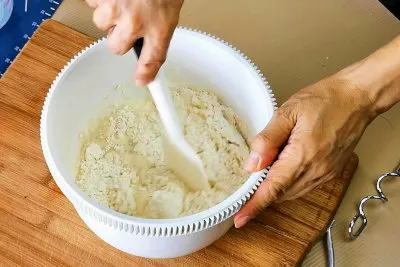
- Continue mixing (or with an electric mixer with the dough hook attached) until it is smooth and stay free from the bowl. Cover and rest for 30 minutes.
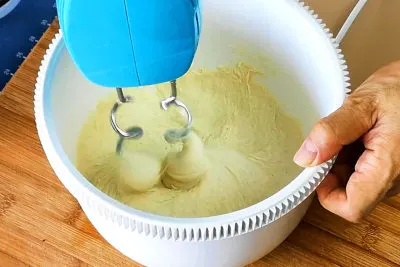
- Mix (B) in a small saucepan. Heat until the oil starts boiling to form a roux. Set aside to cool.
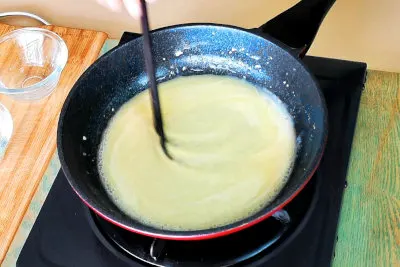
- Divide the dough into four. Roll each portion thinly into a long rectangle.

- Apply the roux on the surface but leave about one cm free from the edges.
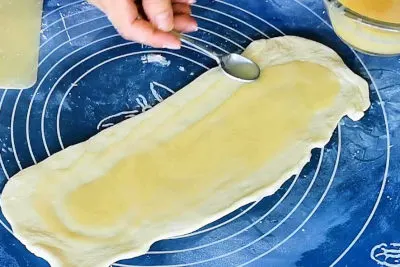
- Sprinkle the salt and spring onion as in (C)) on the surface.
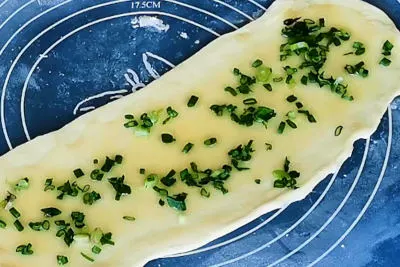
- Roll up the dough like making a Swiss roll. Roll and stretch the dough to form a long rope.
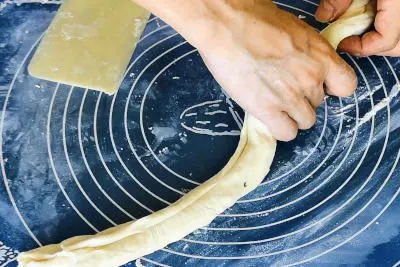
- Coil the rope to form a round dough.
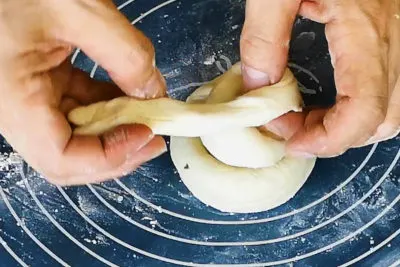
- Roll out to about 1/4 inch thick circle. Pan-fried over medium heat until it has charred lines and speckled spots.
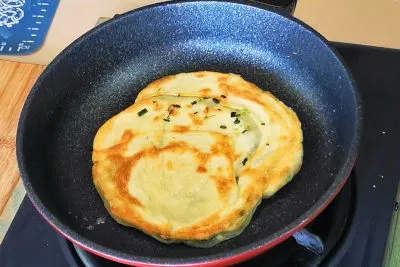
- Flip over and cover the pan for one minute. Remove the cover and continue pan-frying until both sides are golden brown. Remove from heat.
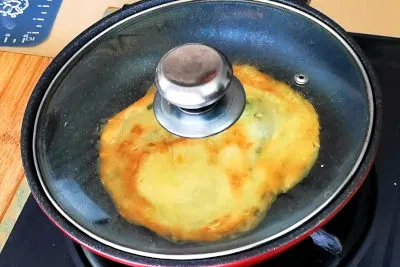
- To make the sauce, simply combine all the ingredients in (D).
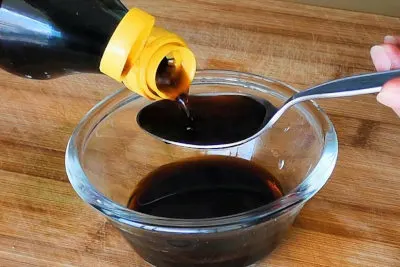
Recommended Products
As an Amazon Associate and member of other affiliate programs, I earn from qualifying purchases.
-
 Di Oro Seamless Series 3-Piece Silicone Spatula Set - 600°F Heat Resistant Non Stick Rubber Kitchen Spatulas for Cooking, Baking, and Mixing - LFGB Certified and FDA Approved Pro-Grade Silicone Black
Di Oro Seamless Series 3-Piece Silicone Spatula Set - 600°F Heat Resistant Non Stick Rubber Kitchen Spatulas for Cooking, Baking, and Mixing - LFGB Certified and FDA Approved Pro-Grade Silicone Black -
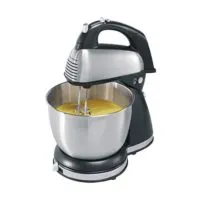 Hamilton Beach 64650 6-Speed Classic Stand Mixer, Stainless Steel, 4-Quart Bowl and Accessories
Hamilton Beach 64650 6-Speed Classic Stand Mixer, Stainless Steel, 4-Quart Bowl and Accessories -
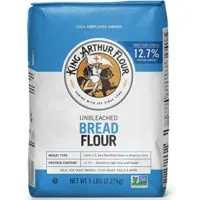 King Arthur Flour Unbleached Bread Flour, 5 Pound (Packaging May Vary)
King Arthur Flour Unbleached Bread Flour, 5 Pound (Packaging May Vary) -
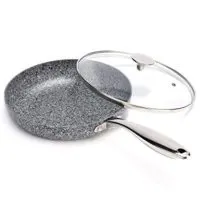 MICHELANGELO Nonstick Frying Pan Stone with Ultra Nonstick Granite Coating, 10 Inch Frying Pan with Lid, Nonstick Skillet Pfoa Free, Non toxic Rock Pan, Induction Compatible -10 inch
MICHELANGELO Nonstick Frying Pan Stone with Ultra Nonstick Granite Coating, 10 Inch Frying Pan with Lid, Nonstick Skillet Pfoa Free, Non toxic Rock Pan, Induction Compatible -10 inch
Nutrition Information:
Yield: 4 Serving Size: 1Amount Per Serving: Calories: 445Total Fat: 21gSaturated Fat: 6gTrans Fat: 0gUnsaturated Fat: 13gCholesterol: 0mgSodium: 1763mgCarbohydrates: 58gFiber: 2gSugar: 0gProtein: 7g
This data was provided and calculatd by Nutrionix on 4/2/2020

Barbara
Monday 8th of January 2024
A wonderful recipe! I've been making the scallion pancake for years, but this recipe is the best I've ever had. Thanks for including the American measurements and keep on cooking!
David
Monday 20th of November 2023
Wonderbah! My wife loves scallion pancakes. I'll let you know how they turned out. Thankyou for the recipe/
Linda
Thursday 23rd of June 2022
I have tried several recipes for scallion pancakes. This one was by far the best I have had. It was flaky and fluffy, restaurant quality, and my family loved it. I was a little pressed for time, so I made the dough and refrigerated it overnight, let it come down to room temperature before rolling. It puffed up some while frying. A few spots did not brown, so I spread some unused roux on the area, flipped it, and it browned perfectly. This is the only recipe I will use now. Thank you for the detailed instruction.
Karen
Wednesday 2nd of February 2022
I can't wait to try this recipe and see how close it is to our local specialty - green onion cakes. I live in Edmonton, Alberta, Canada and green onion cakes have come close to being declared our city's official food!
Oysan
Saturday 11th of September 2021
I followed the recipe but I find the dough is too thick. 2.5 cups of flour to .9 cup of water didn’t combine. I am thinking I need more water. Please comment so I know my error.
KP Kwan
Sunday 12th of September 2021
Please add more water until the consistency fo the dough is as shown in the video. I measured it in metric measurement with a digital kitchen scale in the recipe.